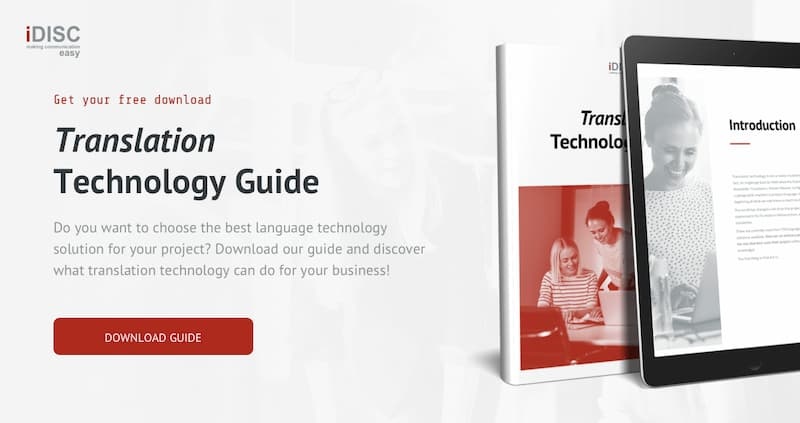The world of translation is progressing at breakneck speed, as machine translation (MT) methods are being increasingly perfected .
Little by little, with these new automated technologies, the need for human intervention in translation processes is decreasing.
The phenomenon of machine translation appeared for the first time in the early 1950s, marking a turning point in the field of translation and completely revolutionizing the sector. This tool makes it possible to translate texts automatically without help from a human translator.
Ever since this technology was first used, a never-ending debate has ensued: will machine translation ever completely replace human translation?
This is what we’ll be taking a closer look at in this article to help you answer any questions you might have.
We’ll also tell you about the main characteristics of each, so you can decide which is best for your needs.
Human translation: our origins
Surprising as it may be, translation dates way back to distant eras. The first evidence of human translation can be found on the Rosetta Stone, an Egyptian decree inscribed on a stone weighing 800 kg and measuring over a meter in height, written in three different languages: Egyptian hieroglyphs, Demotic script and Greek.
This moment marks the beginning of the discipline of translation in terms of study and practice. Translation has been a vital activity for human civilization, accompanying us throughout our history, and it continues to play a key role in today’s society.
The invention of the printing press in the 15th century caused a surge in the activity of human translation. This tool led to a dramatic increase in the use of written language to translate texts into other languages and improve communication between different cultures and societies that spoke different languages.
The role of the translator took on particular importance from the industrial revolution onwards, with the expansion of international trade and diplomacy, and has remained key to sharing scientific and technological advances on a global scale to this day.
Human translation: pros and cons
Techniques and procedures in human translation
Human translation has evolved enormously throughout history, with techniques that have been increasingly refined and the methodology itself becoming a much more exhaustive and efficient process.
Most common techniques in human translation:
- Literal translation: a literal translation of the source text without any changes to the meaning or structure. This type of translation only works when the languages involved share a compatible structure.
- Equivalency: this type of translation aims to be faithful to the tone and message of the original text, changing the structure and style of the source and creating equivalency between the two languages.
- Calque: similar to literal translation, this is used to translate expressions from the source language without necessarily respecting the structure.
- Adaptation: this technique involves adapting cultural elements in the text in order to make sense in the target language so that they make the same sense in the target culture.
- Transposition: it involves an alteration in the grammatical structure of the sentence, but the meaning is not changed.
However, the success of human translation does not lie in these techniques, but rather in the judgment and sensitivity of the person who uses them.
Human translation processes
In general, translators usually follow a series of guidelines that aren’t strictly mandatory, but highly recommended in order to ensure that the translation process is successful. We’ll now take a look at the general stages of the translation process for a standard document.
- Analysis of the document to be translated: this begins with a preliminary reading to identify the subject and style of the original text, as well as the intended purpose of the translation and the working language. This stage also usually involves the selection of supporting resources, such as bilingual and monolingual dictionaries, glossaries, etc.
- Research: necessary preliminary search for parallel texts and information about the subject matter to be translated.
- Translation: understood as the process of transferring information from a text in language A to language B, respecting the author’s intentions and remaining as true as possible to the source text.
- Proofreading: this is a fundamental part of the process that usually focuses on errors related to meaning, grammar and style.
- Delivery: the requested translation is delivered to the client.
Main issues with human translation
The main problem with human translation is the time the translator needs to complete a project. While working environments have evolved and streamline the human translation process, it is still slower than required by the pace of today’s market and its immediacy.
Translators work with computers that speed up the process with the help of various tools, such as word processors that alert users of minor grammar or spelling errors. What’s more, terminology research is much faster thanks to online platforms.
Sadly, this isn’t enough. For a human-rendered translation to be perfect, a lot of time and proofreading are required, resulting in a significantly higher price tag and longer lead times.
However, there are certain tasks for which human translation continues to be the best option. When translating or transcreating marketing content, for example, human sensitivity and creativity are still difficult to replace despite technological advances.
Machine translation: pros and cons
Techniques and procedures in machine translation
If human translation has advanced in recent decades, then machine translation has made unimaginable progress, with a significant impact on the profession itself.
The first automated translations were rule-based (RBMT) and used linguistic information from dictionaries and grammatical resources both for the source and target language.
Later, this was replaced by statistical machine translation (SMT), which analyzed existing bilingual corpora.
The latest trends in machine translation are now dominated by neural machine translation (NMT), which uses artificial neural networks and is being implemented by companies such as Google and Microsoft.
Machine translation processes
The process that machine translation tools usually follow are generally split into three distinct stages:
- Analysis of the source text (ST): Often assisted by Natural Language Processing (NLP), this stage is essential for the tool to properly break down the text and provide the most faithful and accurate translation possible.
- Transfer from source language (SL) to target language (TL): this is the bilingual stage in which the tool automatically produces the translated text based on the information extracted from the analysis, glossaries, translation memories, corpora, etc.
- Target language synthesis: the system adjusts the word order of the phrases in accordance with the TL, following specific rules, and renders the translation.
Main issues with machine translation
While machine translation has made considerable leaps, it’s still IT software and is not yet 100% comparable to the human mind.
One of its main weaknesses in the preliminary analysis of the source text is usually the recognition of nuances according to the context. This continues to be a complicated challenge for machine translation software, even with the help of translation memories stored from previous translations.
Cultural context and meanings in the source and target languages are still difficult to identify for automated tools.
While in recent years they have undergone a process of refinement and will continue to do so at an accelerating pace, the reality is that, for the time being, machine translation cannot completely replace human translation. They must work together for the same cause: to achieve increasingly accurate translations with a more efficient process. As a result, many companies choose to use machine translation and carry out a postediting process.
The postediting process involves the translation of a corpus by machine translation followed by proofreading carried out by a human translator. This way, mistakes that the machine translation tool has not properly resolved can be detected, but without the delays associated with a translation carried out solely by a human translator.
The evolution of translation software
There is a plethora of machine translation engines out there, both public and private. Some of the most widely used nowadays, including both free-to-use versions and advanced paid versions, are:
- Google Translate
- Systran
- Bing Microsoft translation
- Alibaba (eCommerce Model)
- Tilde MT
- Amazon Translate
All of these engines help to translate texts faster and more efficiently. Although these machine translation tools are being refined, they still make mistakes, such as grammatical errors and issues with context or terminological coherence. These vary considerably depending on the language pair or knowledge area.
The need for human translation depends more on the nature and purpose of the text, but this is a complex topic that requires further unpacking.
We hope this article has been useful in shedding light on any questions you may have had and that it helps you choose the translation service that’s best suited to your needs. You can find more related content on our blog or you can get in touch for further information.



.jpg?width=370&height=200&name=idisc-empresa-de-traduccion-profesional%20(1).jpg)
